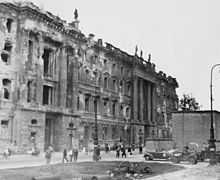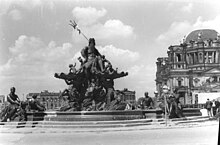Neptune Fountain (Berlin)
| Neptune Fountain Castle Fountain |
|
|---|---|
| General view of the Neptune Fountain | |
| place | Berlin center |
| country |
|
| use | Fountain |
| construction time | 1888-1891 |
| architect | Reinhold Begas |
| Architectural style | Neo-baroque |
| Technical specifications | |
| height | 10 m |
| diameter | 18 m |
| Floor space | 250 m² |
| Building material | Red granite , bronze |
| Coordinates | |
| location | Coordinates: 52 ° 31 ′ 11 " N , 13 ° 24 ′ 24" E 52 ° 31 ′ 11 " N , 13 ° 24 ′ 24" E |
The Neptunbrunnen (actually Schloßbrunnen , also Begasbrunnen ) is a monument in the Berlin district of Mitte . Erected in the neo-baroque style by Reinhold Begas on Schloßplatz in the years 1888-1891 , it was removed after the castle was demolished in 1951 and placed in the park by the television tower between the Red Town Hall and the Marienkirche during the redesign of East Berlin's city center in 1969 .
The Neptune Fountain, consisting of a four-pass granite basin and five allegorical bronze figures, is the largest and most important fountain in the city. In connection with the reconstruction of the Berlin Palace as a Humboldt Forum , the return of the Neptune Fountain to the Schlossplatz is discussed.
history
Its construction goes back to a suggestion by Karl Friedrich Schinkel to erect a monumental fountain on the Schloßplatz opposite the confluence with Breite Straße . The young Reinhold Begas took up this idea after traveling to Italy . After Baroque Italian and French models, especially the Neptune , Vierströme- and Mohrenbrunnen on the Piazza Navona in Rome and the Latona fountain in the palace gardens of Versailles , he designed in the 1870s several versions, the last from 1888 to 1891 was carried out. The castle fountain was inaugurated on November 1st, 1891 as a gift from the Berlin magistrate to Kaiser Wilhelm II . The location in front of Portal II of the palace originally served as the omphalos (i.e. the center of Berlin) from which the Prussian mile was measured.
Begas has become famous for this work, which is one of the largest artistic fountains in the world. His brother Karl Begas (1845–1916) and his (former) master students , the sculptors Karl Albert Bergmeier (1856–1897), Karl Bernewitz (1858–1934) and Johann Götz (1865–1934) supported him in the execution .
The well, which was walled in in 1942, survived the Second World War unscathed. Uncovered in 1946, non-ferrous metal thieves damaged the figures. After the castle was blown up, which left further damage to the fountain, the figures were stored in 1951 and the shell made of polished red Swedish marble , which had previously looked like a mirror , was destroyed. In 1969 the fountain in the park at the television tower , which was built in place of the Marienviertel that was destroyed in the Second World War and then demolished , was re-erected between the Marienkirche and the Red City Hall . Before that, the sculptor Hans Füssel and the art and bell foundry Lauchhammer had restored the figures from 1967. The new fountain bowl is made of red Jawlensk granite ( Transbaikalia region ), the outer steps of gray granite. Since the reconstruction, it has been called the Neptune Fountain - denying its historical location.
Dimensions and description
The widest diameter of the four-pass fountain bowl is 18 meters; it is made of red polished granite. The middle part up to the vertex of Neptune is 8.50 meters high and up to the trident 10 meters.
In the center of the fountain bowl is a rock plinth, surrounded by marine animals such as lobsters, crabs, fish and polyps, as well as water-spouting sea and river animals: sea turtles, seals, crocodiles and snakes. Putti play with the wet element and four water-spouting tritons in the style of the centaurs carry a large clam shell with the powerful figure of the ancient Roman sea god Neptune. He has thrown the symbol of his power, the undulating trident, over his left shoulder and his right arm on his thigh. Four aquatic animals in the basin also spew fountains towards the center of the facility. All figures are cast from bronze and highlighted by an artificial light green patina.
Allegories
At the edge of the bowl sit four female figures who represent the personification of what were formerly four German rivers, supplemented by characteristics of the landscapes through which they flow :
- Rhine (fish net and grapes),
- Vistula (wooden blocks, symbol for forests),
- Or (goat and fur) as well
- Elbe (ears and fruits).
Location discussion
In connection with the reconstruction of the Berlin Palace as a Humboldt Forum , there are discussions about moving the Neptune Fountain to its original location on the Schlossplatz . Proponents of a relocation argue with the alignment of the Neptune Fountain on the facade of the palace, the center of the palace square and the axis of the Breite Straße . Among them are Wilhelm von Boddien (head of the Friends of the Berlin Palace ), Stefan Evers (building policy spokesman for the CDU parliamentary group), Wolf-Dieter Heilmeyer (former director of the Berlin Collection of Antiquities ), Klaus von Krosigk ( retired deputy state curator) , Bernd Wolfgang Lindemann (art historian), Manfred Rettig (former head of the Berlin Palace Foundation ), Lea Rosh (publicist), Franco Stella (architect of the Humboldt Forum), the Berlin Architects and Engineers Association , the Berlin Citizens' Forum, the Historical Berlin Society and the Future Berlin Foundation . In November 2015, the federal government released ten million euros for the relocation of the Neptune Fountain. In May 2020, Berlin's Governing Mayor Michael Müller ( SPD ) agreed to be transferred to Schloßplatz if the concept for a replacement is available at the previous location.
However, critics of a relocation argue with the design function of the Neptune Fountain on the town hall forecourt. The red-red-green Senate of Berlin is also in favor of keeping the fountain at its current location. Alternatively, Andreas Otto , the spokesman for the Green Party on building policy , suggests a copy of the Neptune Fountain on Schloßplatz .
According to a representative survey by Infratest dimap in May 2017, 47 percent of Berliners (49 percent of respondents nationwide) are in favor of relocating the Neptune Fountain to its original location on Schloßplatz. Only 37 percent are in favor of staying at the current location on the town hall forecourt.
Others
- At first the Berliners jokingly called the fountain For (c) kenbecken , alluding to the then mayor Forckenbeck and the “ fork ” of Neptune.
- The four women on the edge of the fountain, allegorically depicting four large German rivers, are supposedly the only women in Berlin who can “hold the edge ( dialect for mouth)” in the vernacular of Berlin . "Begas, Begas, you truly performed miracles, you created the first Berlin women who hold the edge [...]"
- In Phantasialand near Brühl there was a replica of the Neptune fountain on a scale of 1: 2 until 2008.
- The significantly smaller Wrangel Fountain, built eleven years earlier, personifies the same “Prussian rivers”.
literature
- Dagmar Claus: November 1st, 1891: The Neptune Fountain is unveiled . In: Berlin monthly magazine ( Luisenstädtischer Bildungsverein ) . Issue 11, 1996, ISSN 0944-5560 , p. 72-74 ( luise-berlin.de ).
Web links
- Entry in the Berlin State Monument List with further information
- Schlossbrunnen - sculpture in Berlin
- Description of the fountain at stadtentwicklung.berlin.de
- Neptune Fountain Berlin - Interactive 360 ° Panorama
Individual evidence
- ↑ The Omphalos and the Neptune Fountain, Förderverein Berliner Schloss e. V., September 14, 2016
- ↑ The Neptune Fountain . (PDF; 5.9 MB) Gesellschaft Berliner Schloss e. V .; Retrieved December 25, 2012
- ↑ Esther Sophia Sünderhauf (ed.): Begas. Monuments for the Empire. An exhibition on the 100th anniversary of the death of Reinhold Begas (1831–1911). Sandstein, Dresden 2010, ISBN 978-3-942422-15-4 , p. 225.
- ↑ Thomas Topfstedt: Urban development in the GDR 1955–1971 . VEB E. A. Seemann Verlag, Leipzig 1988, ISBN 978-3-363-00364-2 , p. 78.
- ↑ Esther Sophia Sünderhauf (ed.): Begas. Monuments for the Empire. An exhibition on the 100th anniversary of the death of Reinhold Begas (1831–1911). Sandstein, Dresden 2010, ISBN 978-3-942422-15-4 , p. 366
- ↑ Institute for Monument Preservation (Ed.): The architectural and art monuments of the GDR. Capital Berlin-I . Henschelverlag, Berlin 1984, p. 37 ff .
- ↑ Isabell Jürgens: The Neptune Fountain should be back in front of the city palace . ( Morgenpost.de [accessed on May 12, 2018]).
- ↑ ghb-online.de
- ↑ Manfred Rettig: The Neptune Fountain belongs in front of the castle . Polemics by the Friends of the Berlin Palace; accessed on June 30, 2015.
- ^ Culture: Association wants Neptune fountain in front of the city palace . In: The world . February 12, 2013 ( welt.de [accessed on May 12, 2018]).
- ↑ planungsgruppe-stadtkern.de
- ↑ Isabell Juergens: The struggle to rebuild Berlin's center . ( Morgenpost.de [accessed on May 12, 2018]).
- ^ Stiftung Zukunft Berlin wants the god of the sea in a historical location . In: Berlin Week . ( berliner-woche.de [accessed on September 5, 2018]).
- ↑ Isabell Jürgens: Federal government provides funds: Neptune fountain should be back in front of the city palace . In: morgenpost.de , November 13, 2015, accessed on March 5, 2016.
- ↑ Kiek times on! Fielmann optician donated 13 castle trees. Accessed May 31, 2020 .
- ↑ Ulrich Paul: Katrin Lompscher: Neptune fountain in good hands at its current location . In: Berliner Zeitung . ( berliner-zeitung.de ).
- ↑ Mike Wilms: Wacky idea: Greens want to clone Neptune wells . In: Berliner-Kurier.de . ( berliner-kurier.de [accessed on May 12, 2018]).
- ↑ Survey: Half of Berliners are against the unified monument . According to the survey, Neptune fountain and horse tamers should return. ( bz-berlin.de [accessed June 4, 2017]).
- ↑ Gisela Heller: New Märkischer Bilderbogen: Reporter between Havel and Oder . Verlag der Nation, Berlin 1986, ISBN 978-3-373-00113-3 , p. 358.





